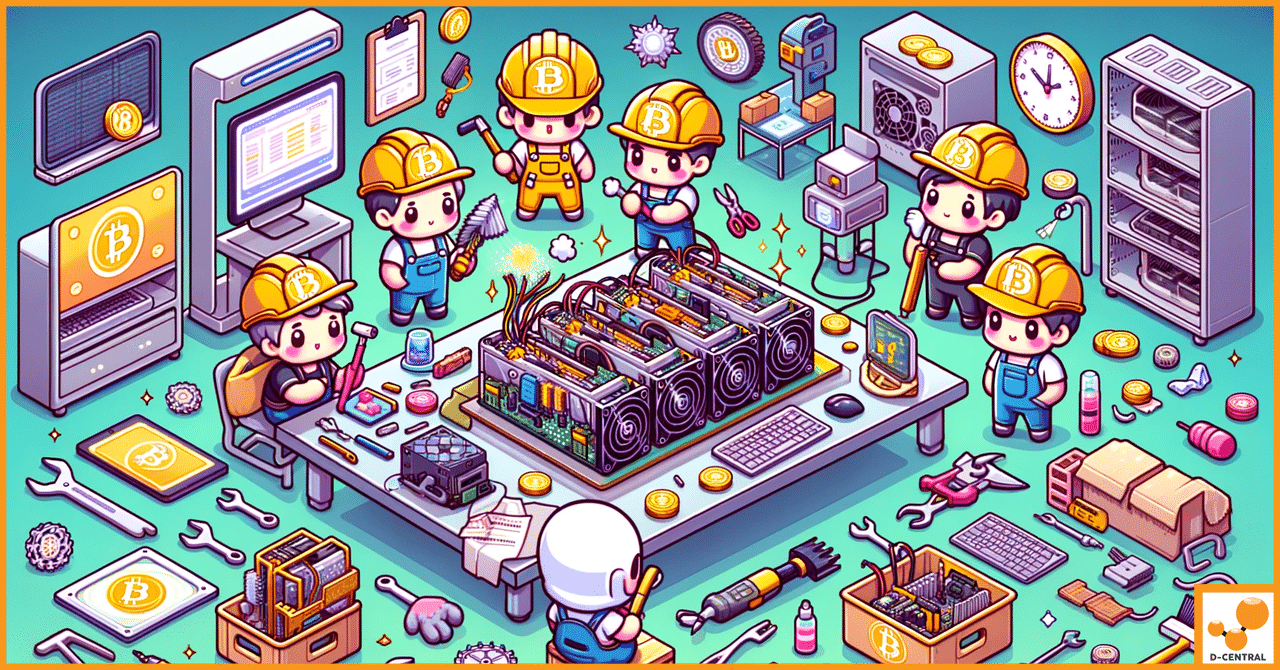Powerful Antminer L7 Review: Optimize Your Litecoin & DogeCoin Mining Setup
Released in November 2021, the Antminer L7 by Bitmain is designed for efficient Litecoin and Dogecoin mining. Known for its
4479 Desserte Nord Autoroute 440, Laval, QC H7P 6E2

In the ever-evolving landscape of cryptocurrency mining, the efficiency and longevity of mining hardware stand as pivotal factors determining the profitability and sustainability of mining operations. As the backbone of the blockchain network, mining hardware, particularly ASIC miners, requires meticulous attention and care to ensure optimal performance. This guide delves into the critical practice of mining hardware maintenance, with a spotlight on the most prevalent ASIC miners in the industry, including the renowned Antminer and Whatsminer models.
The significance of regular maintenance cannot be overstated. It is the linchpin that holds the potential to significantly extend the operational lifespan of mining equipment, thereby safeguarding the investment made into these often costly machines. Beyond the extension of hardware life, diligent maintenance routines are instrumental in enhancing the efficiency of mining operations. Clean, well-maintained hardware operates at peak performance, ensuring maximum hash rates and minimizing the occurrence of costly downtimes.
Moreover, the proactive upkeep of mining hardware mitigates the risk of unexpected failures and the subsequent urgent repairs that can sideline mining operations. By identifying and addressing minor issues before they escalate into major complications, miners can avoid the inconvenience and expense of significant downtime. This not only preserves the hardware’s value but also ensures a steady stream of mining output, reinforcing the overall profitability of mining ventures.
In this comprehensive guide, we will explore the various facets of mining hardware maintenance, offering insights and practical advice tailored to the unique needs of ASIC miners. From routine cleaning procedures to advanced troubleshooting techniques, this guide aims to equip miners with the knowledge and skills necessary to maintain their hardware in prime condition, thereby maximizing efficiency and prolonging the operational lifespan of their mining equipment.
To ensure the longevity and efficiency of your mining operations, a deep understanding of your mining hardware is essential. This section provides a foundational overview of ASIC miners, detailing their components and the role each plays in mining performance. Additionally, we’ll explore the landscape of mining hardware, highlighting the diversity in ASIC models and briefly touching upon other mining technologies like GPU and FPGA miners.
ASIC (Application-Specific Integrated Circuit) miners are the gold standard in the realm of cryptocurrency mining, designed specifically for the task of mining cryptocurrencies like Bitcoin. These devices are engineered to offer the highest hash rates while maintaining energy efficiency, a balance crucial for profitable mining operations. Here’s a breakdown of the key components found in ASIC miners and their functions:
Understanding the role and importance of each component within an ASIC miner is the first step in effective maintenance. Regular checks, cleaning, and updates can help each part function optimally, contributing to the miner’s overall performance and longevity.
While ASIC miners dominate the Bitcoin mining scene, the market offers a variety of models, each with specific characteristics and maintenance needs. Two of the most prominent ASIC models include:
In addition to ASIC miners, GPU (Graphics Processing Unit) miners and FPGA (Field-Programmable Gate Array) miners also play roles in the broader mining ecosystem, particularly in mining cryptocurrencies that require different computational algorithms. While not as efficient as ASICs for Bitcoin mining, GPUs and FPGAs offer flexibility in mining various cryptocurrencies and require their own specific maintenance routines, focusing on software updates, cooling, and power supply management.
By understanding the specific needs and components of your mining hardware, whether ASIC, GPU, or FPGA, you can tailor your maintenance practices to ensure each device operates at its best, maximizing your mining efficiency and profitability.
Before diving into the maintenance of your mining hardware, preparing with the right tools and safety measures is crucial. This preparation not only facilitates a smoother maintenance process but also ensures the safety of both the individual performing the maintenance and the hardware itself. Here’s what you need to know to set yourself up for success.
Having the right tools and supplies on hand is essential for effective and efficient maintenance of your mining hardware. Here is a list of the essentials:
When performing maintenance on mining hardware, safety should always be the top priority. Here are some safety precautions and best practices to follow:
By adhering to these safety precautions and best practices, you can ensure a safe and successful maintenance process, protecting both yourself and your valuable mining hardware from potential harm.
Regular maintenance is crucial for the optimal performance and longevity of ASIC miners. This section outlines the essential routine maintenance procedures, including cleaning, cooling system upkeep, and firmware updates.
Dust and debris accumulation can significantly impact the efficiency and lifespan of your ASIC miners. Follow this step-by-step guide to ensure your miners remain clean and functional:
The cooling system is vital for maintaining miner efficiency and preventing overheating. Proper maintenance ensures that your ASIC miners operate within optimal temperature ranges.
Firmware plays a critical role in the performance and security of ASIC miners. Regular updates can enhance efficiency, introduce new features, and patch security vulnerabilities.
By adhering to these routine maintenance procedures, you can significantly enhance the performance, efficiency, and lifespan of your ASIC miners, ensuring your mining operation remains profitable and sustainable.
For those looking to maximize the performance and extend the lifespan of their mining hardware, delving into advanced maintenance techniques is essential. This section covers the intricacies of hash board maintenance, PSU care, and the utilization of monitoring and diagnostics tools.
The hash board is one of the most critical components of an ASIC miner, responsible for the heavy lifting of mining operations. Proper maintenance and troubleshooting of the hash board can significantly impact the efficiency and productivity of your mining hardware.
The PSU is vital for providing stable and efficient power to your mining hardware. Ensuring its proper function is crucial for the safety and performance of your mining operation.
Leveraging software tools for monitoring and diagnosing your mining hardware can provide insights into its health and performance, allowing for proactive maintenance.
By incorporating these advanced maintenance techniques into your routine, you can significantly enhance the performance and reliability of your mining operation, ensuring that your hardware remains in top condition for as long as possible.
Even with diligent maintenance, mining hardware can encounter issues that affect performance and efficiency. Understanding how to troubleshoot common problems is essential for minimizing downtime and maintaining optimal operation. This section provides guidance on diagnosing and addressing frequent issues, as well as advice on when to seek professional repairs.
Low Hash Rate
Overheating
Unexpected Shutdowns
While many common issues can be addressed with basic troubleshooting, some problems require the expertise of a professional repair service. Here’s how to evaluate repair needs and select a reputable provider:
Evaluating Repair Needs
Selecting a Reputable Service Provider
By effectively troubleshooting common issues and knowing when to seek professional repairs, you can ensure that your mining hardware remains in optimal condition, contributing to the overall success and profitability of your mining operation.
Ensuring the longevity and efficiency of your mining hardware requires not just immediate fixes but also a strategic approach to maintenance over the long term. Implementing a structured maintenance schedule and meticulous record-keeping can significantly enhance the performance and lifespan of your mining equipment. This section outlines how to establish these practices within your mining operation.
Importance of Regular Maintenance Regular maintenance is crucial for preventing hardware failures, optimizing mining efficiency, and minimizing downtime. It helps identify potential issues before they escalate into major problems, saving time and resources in the long run.
How to Create a Maintenance Schedule
Importance of Detailed Maintenance Logs Keeping detailed logs of maintenance activities and hardware performance helps in diagnosing future problems, planning upgrades, and optimizing operational efficiency. It provides a historical record of the health and performance of your mining hardware.
How to Keep Maintenance Logs and Track Performance
Implementing these long-term maintenance strategies will not only prolong the life of your mining hardware but also optimize its performance, ensuring your mining operation remains competitive and profitable over time.
The journey through the meticulous world of mining hardware maintenance underscores a fundamental truth: the health and efficiency of your mining operation hinge significantly on the care and attention you devote to your equipment. From the intricate components of ASIC miners to the robust systems powering GPU and FPGA mining rigs, each piece of hardware benefits profoundly from regular maintenance, ensuring that your venture remains both profitable and sustainable.
We’ve navigated through the essentials of cleaning, the criticality of cooling systems, the nuances of firmware updates, and beyond—each step revealing the potential to enhance performance, extend hardware lifespan, and preempt costly downtimes. Advanced techniques, including hash board care and PSU maintenance, further illuminate paths to optimizing your mining operation’s backbone.
Implementing the strategies and practices outlined in this guide is not merely a recommendation; it’s a blueprint for success. Regular maintenance, coupled with diligent record-keeping and performance tracking, lays the foundation for a mining operation that not only survives but thrives in the competitive landscape of cryptocurrency mining.
As we conclude this comprehensive exploration, we invite you, the reader, to share your insights and experiences. Your maintenance tips and stories enrich the collective knowledge of the mining community, fostering a culture of continuous improvement and shared success. Moreover, we encourage you to stay connected and informed by subscribing for updates on the latest advancements in mining technology and maintenance practices. Together, let’s navigate the future of mining with confidence, armed with the knowledge and tools to maintain the cutting edge of efficiency and performance.
Your journey through mining hardware maintenance is a testament to your commitment to excellence. Let this guide be your compass, guiding your operation to new heights of efficiency and profitability.
Why is regular maintenance important for ASIC miners?
Regular maintenance is crucial for extending the operational lifespan of ASIC miners, enhancing efficiency, and preventing unexpected failures. It ensures that mining hardware operates at peak performance, maximizing hash rates and minimizing downtimes.
What are ASIC miners and how do they work?
ASIC (Application-Specific Integrated Circuit) miners are specialized hardware designed specifically for cryptocurrency mining, offering high hash rates and energy efficiency. They consist of components like hash boards, control boards, and cooling systems to perform intensive computational work.
How often should ASIC miners be cleaned?
ASIC miners should be cleaned every 3 to 6 months, though more frequent cleaning may be necessary in dustier environments. This helps prevent dust and debris accumulation, which can negatively impact mining efficiency and hardware lifespan.
What are some common types of ASIC miners?
Common types of ASIC miners include Antminer models produced by Bitmain, known for their efficiency and high hash rates, and Whatsminer models by MicroBT, recognized for their durability and competitive performance.
How can firmware updates affect ASIC miners?
Firmware updates are vital for improving efficiency, introducing new features, and fixing security vulnerabilities in ASIC miners. Regularly updating firmware ensures miners operate with enhanced performance and security.
What are advanced maintenance techniques for ASIC miners?
Advanced maintenance techniques include hash board maintenance, power supply unit (PSU) care, and utilizing monitoring and diagnostics tools. These practices help optimize performance, prevent hardware failures, and extend the lifespan of mining equipment.
How can troubleshooting common mining hardware issues benefit my operation?
Effectively troubleshooting common issues, such as low hash rate, overheating, and unexpected shutdowns, minimizes downtime and maintains optimal operation. This contributes to the overall success and profitability of your mining operation.
Why should mining operations create a maintenance schedule?
Creating a structured maintenance schedule ensures that all necessary tasks are performed regularly, preventing hardware failures, optimizing efficiency, and minimizing downtime. It helps identify potential issues before they escalate into major problems.
What role does record-keeping play in mining hardware maintenance?
Keeping detailed logs of maintenance activities and hardware performance aids in diagnosing future problems, planning upgrades, and optimizing operational efficiency. It provides a historical record of the health and performance of your mining hardware.
DISCLAIMER: D-Central Technologies and its associated content, including this blog, do not serve as financial advisors or official investment advisors. The insights and opinions shared here or by any guests featured in our content are provided purely for informational and educational purposes. Such communications should not be interpreted as financial, investment, legal, tax, or any form of specific advice. We are committed to advancing the knowledge and understanding of Bitcoin and its potential impact on society. However, we urge our community to proceed with caution and informed judgment in all related endeavors.
Related Posts
Released in November 2021, the Antminer L7 by Bitmain is designed for efficient Litecoin and Dogecoin mining. Known for its

In the ever-evolving landscape of digital currencies, Bitcoin stands as a pioneering force, reshaping how we perceive and engage with

In the dynamic world of cryptocurrency mining, Antminer devices have established themselves as the cornerstone of efficient and profitable mining